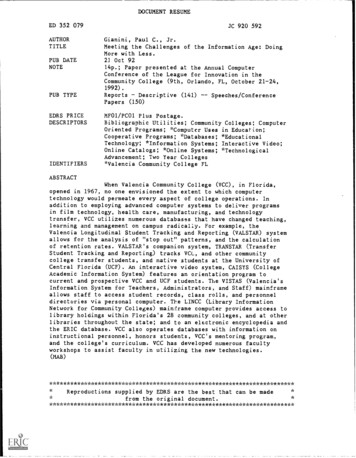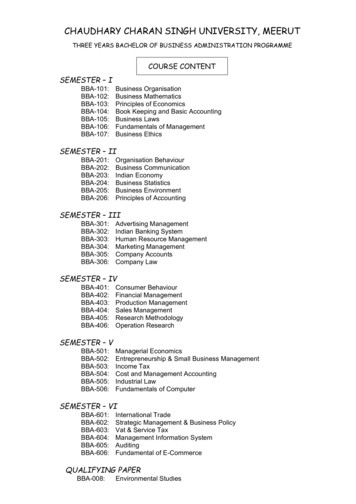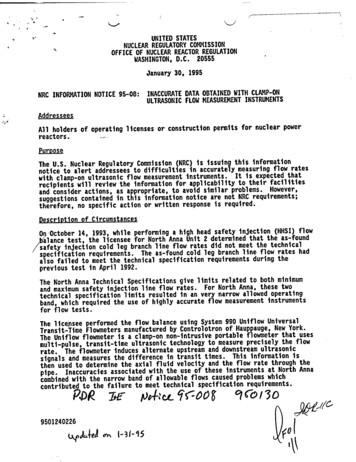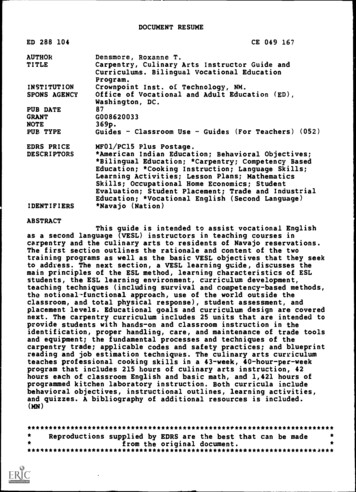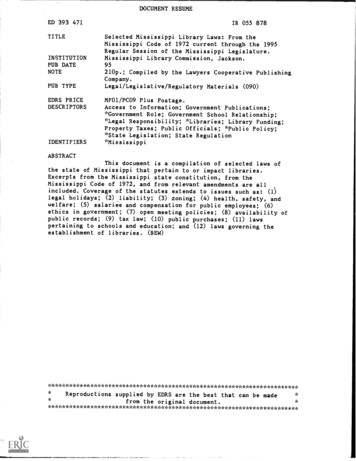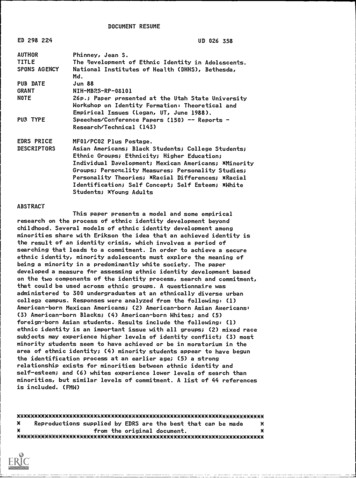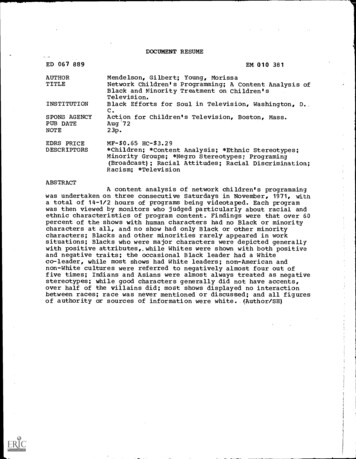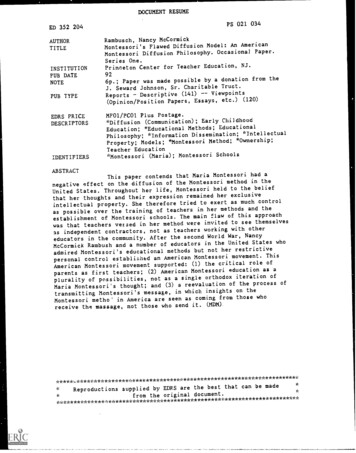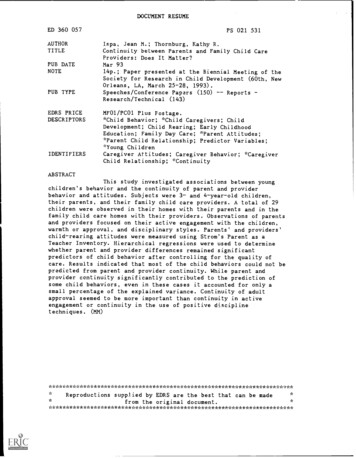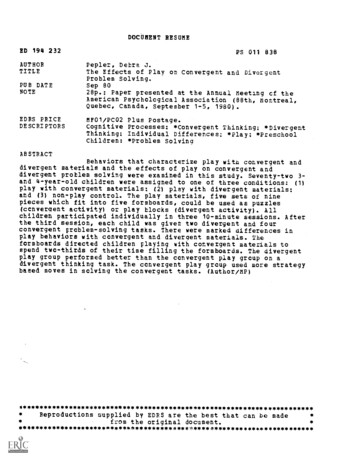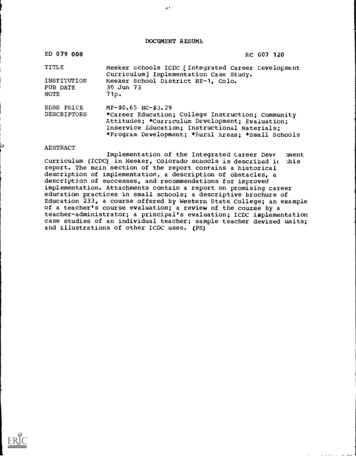
Transcription
DOCUMENT RESUME.ED 079 008TITLEINSTITUTIONPUB DATENOTEEDRS PRICEDESCRIPTORSRC 007 120Meeker Schools ICDC [Integrated Career EevelopmentCurriculum] Implementation Case Study.Meeker School District RE-1, Colo.30 Jun 7371p.MF- 0.65 HC - 3.29*Career Education; College Instruction; CommunityAttitudes; *Curriculum Development; Evaluation;inservice Education; Instructional Materials;*Program Development; *Rural Areas; *Small SchoolsABSTRACTImplementation of the Integrated Career DevE-AnentCurriculum (ICDC) in Meeker, Colorado schools is described it :hisreport. The main section of the report contains a historicaldescription of implementation, a description of obstacles, adescription of successes, and recommendations for improvedimplementation. Attachments contain a report on promising careereducation practices in small schools; a descriptive brochure ofEducation 233, a course offered by Western State College; an exampleof a teacher's course evaluation; a review of the course by ateacher-administrator; a principal's evaluation; ICDC implementationcase studies of an individual teacher; sample teacher devised units;and illustrations of other ICDC uses. (PS)
-XMEEKER SCHOOLS ICDC IMPLEMENTATION CASE STUDYJune 30, 1973hleeK.er-, Colorado.0--NCDC:iLLJHISTORICAL DESCRIPTION OF IMPLEMENTATIONThe Meeker Community has for many decades shared with most otherrural communities the strong emphasis (perhaps overemphasis) on abasically college prep curriculum in its high school with .everalThese included a growing interest in vocationalnotable exceptions.preparation as exemplified in a vocational agriculture program (enrollingover 70% cf high school boys) and an office occupations program(enrolling over 70% of the students). Also, a strong staff interest inindividualized learning, use of technology, and scheduling modificationsErcouragement and supportwas either tolerated or actively supported.for these activities were obtained through the school's association withthe Rocky Mountain Area Project and its successor the Western StatesSmall School Project.Meeker piloted an effort towards using local businesses for jobexperiences, called Vocational Exploration (See Attachment A), in themid 1960's. This pilot effort (which is still in existence, serving 40high school students annually) was used to justify to the Ford Foundationthe Career Selection Program of WSSSO%hich Meeker participated in. Thiseffort in turn led to the identification of the special needs andcircumstances existing in rural schools which suggested the ICDC project.The Meeker administrators were aware of and had some input into theAlso, two Meeker high school teachers,writing of the ICDC proposal.Mr. Charles Jaquette and Mr. Don Blanke were on the team of ICDC writersthat worked during the summer of 1969 in Salt Lake City, Utah.COMMITMENT AND INVOLVEMENTDuring the past 10 years, Meeker has had the same superintendent andtwo high school principals, all of whom were made aware at various WSSSPThus there has beenmeetings and workshops of the progress of the ICDC.TheBoardofEducation has beena continuing administrative commitment.consistentin support,informed all along on such progress and has beenrecognizedneedinourschool.feeling that ICDC addressed itself to atheprogramhavebeenThe minor budget amounts necessary to supportwillingly provided.Faculty commitment to ICDC implementation has varied from indifferenceto full dedication, with at least half of the staff being involved in thedevelopment of the ICDC over a several year period. Skepticism has beenexhibited by many of the staff but this has been softened somewhat byreasonable tolerance and most have been intrigued with at least someaspects of the curriculum.0-1xrrl'elA /am4tAtferateci Career' bi--4/44)11164f0itWe5terA Staie5 %-yv,al\ SoArt-vo k Pr-teeet.U s DEPARTMENT OF HEALTH,EDUCATION &WELFARENATIONAL INSTITUTE OFEDUCATIONQS)I HIS DOCUMENT HAS BEEN REPRODUCED EXACTLY AS RECEIVED FROMOTHE PERSON OR ORGANIZATION ORIGINATING IT PO'NTS OF VIEW OR OPINIONSSTATED DO NOT NECESSARILY REPRESENT OFFICIAL NATIONAL INSTITUTE OFEDUCATION POSITION OR POLICYQ--.'FILMED FROM BEST AVAILABLE COPY,
Page 2Meeker SchoolsThe community has been aware and supportive of our interest ininvolved with the ICDCcareer education but have only been indirectlyVery little directwordofmcuth.efforts through their children orButtheyhavesupported andinvolvethem.effort has been made tohaveprovided the work stations for our Vocational Exploration program,for secondarysupported school budgets which include sizeable outlaysdegree of extoleratedaconsiderablevocational courses, and haveperimental efforts in the local schools-though at some times with extremedubiousness on the parts of a few people.recognition ofTwo local efforts have indicated the community'sago ofcareer education needs. One was their support several yearsfailedbecausean area vocational school proposal (which subsequentlylocatedfailedin a bondthe nearby community where the school was to beTheerectbuildings).issue vote for the local share cf funds needed toother instance is. the local Accountability- Contract Accreditationaddition of aCommittee's authenticating through an opinionnaire theschool system."Career Education" goal to the list of goals for the localMATCHING ICDC AND SCHOOL NEEDSand smallThe ICDC was designed to meet the needs of rural youthstateprojectrural schools as recognized by staffs of such schools andSinceMeekerwasonedirectors who had been working with such schools.excellentof tiv:se schools it is natural that there seemed to be anlocal need.match between ICDC objectives, concepts, materials and theof graduates,We too had the restricted curriculum, the the large proportion enteringhighperpupilcollege, the low pupil-teacher ratio correlated with thecosts, all typical of small rural western schools. A school surveyof jobs inmade of graduates from 1956-1965 revealed the vast rangetwo areaswhich ex-students were now engaged with no more than one orgraduating classes,being represented by more than 4 people from the 10To providereturned.according to the approximately 250 questionnairesspecific jobspartofthesemanyspecific vocational training for evenSince the attemptwould be financially and logistically impossible.hadfailed,noanswersto the needs werefor an area vocational schoolthat most, ifpossible in this direction. It is interesting to noteextremely criticalnot all, staff members (even in cases where they areconcepts ofof specific ICDC materials) are generally supportive of thethe ICDC.SCHOOL POLICIESratherNo change in school policy was needed since there has been allowinglongstanding policy on the part of the Board and Administrationand methodsindividual teachers freedom to choose curriculum materialswiththenecessaryof instruction and to support them in their choicesfacilities and resources.
Page 3Meeker SchoolsReasonable experimentation has been encouraged as has individualizationFlexible schedulingof instruction and a wide use of community resources.toICDCimplementation,haveand crediting arrangements, both conduciveIftheaboveschool.been in existence for a number of years in our highhad not been so, it would have been advisable to have sought a waiver ofany restrictive policy or practice which might impede the tryout orimplementation of the ICDC.STORAGE OF MATERIALSThe original material came in boxes and nothing was coded. Threeteachers spread the materials all over one classroom and proceeded toThese materials were then stored in boxes until time forcode the units.review by the teachers. and then they were placed on individual desks forreview.With the shipment of the next materials, we were also sent an indexand coding numbers for the units.We then took the original shipment of materials and recoded the unitsusing the index sheet.These units were placed in file folders with the code number on eachfolder for reference and easy handling. These were then put into threeboxes and stored on a table in an unused office. The Basic TechnologyUnits were placec' on three shelves with index cards between each set ofunits.We then made a chart for the teachers ff, record the units that theyhad taken out so that we could keep track of the units.Two master sets of the ICDC units were saved, one for easy scanningby teachers, which was placed in the unused office, and one was placed inthe Superintendent's office for a security copy to make duplicates fromif all other copies were used or lost.INSERVICE TRAINING ACTIVITIES.,--Following the selection of Meeker as one of four Colorado schooldistricts to participate in the ICCot, program, a planned schedule of inDuring the summer of 1969 Don Blanke,service became a necessity.Meeker Counselor, was employed to investigate world of work and careerguidance deficiences so that materials could be developed to allow ruralIn February, 1971,youth the same advantages as their urban counterparts.to the materialsan implementation meeting was held to orient the schoolsDurango,Colorado,in Augustavailable. An indepth workshop was held in1971 for two representatives of Meeker. Community orientation, implementation design, faculty implementation, and a record keeping system weredeveloped.
Page 4Meeker SchoolsIn January 1972 a small group met in Las Vegas to provide feedbackA 100 honorarium was offered-11 problems concerning the materials.for teachers who developed carrier projects based on the ICDC materials.The materialsProject school teachers were invited to develop them.were revised and coded during the summer of 1972. A conference was calledfor August, 1972, to review these materials.Because of money limitations one school district in each state wasselected to continue testing the ICDC materials and implementing themMeeker received the endorsement of the WSSSPinto the present curriculum.board.Since the selection of Meeker the following inservice has beenconducted:The plan for 1972-73 was to develop a college credit inservice course toprovide added incentive to all staff members. Twenty-eight facultySeveral were elementary personnel whomembers registered for the class.carrierprojectapproach to learning. Thewere interested in therequirements for the class were:1.2.Participants were to review at least 10 units in each domain, BasicTechnology, Society and Work, and Career Guidance, and were asked tokeep notes from the reviews as to potential uses, strengths, difficulties, etc.Participants were to.select units or carrier projects that could beused in their clas-trooms as they were written cr m-di fy presentunits for such use, or to create new units or carrier projects forclassroom use.3.Participants were to try the materials selected (or modified orcreated) in the classroom and report results (negative or positive).Outside consultants were invited into the school district forExamples werepresentations on various aspects of career development.Dr. Robert Taylor, Mr. Harrell Guard, Dr. Ed Moe, Dr. Robert Whittemore,Dr. Chet Hauskins, Dr. Henry Isaacson, Dr. Rodney Anderson and Mr. HerbSteffens.A notebook was developed providing evidence of work done by eachIt is on file at the WSSSP Project headquarters inclass participant.Thegeneralconsensus of the ICDC inservice training wasCarson City.that it was the most effective factor in promoting use of the ICDCmaterials by the Meeker faculty.(Attachments B - Descriptive Brochure of Education 233, and C Example of Teacher's Course Evaluation, Time 121, and Materials Review,and D - review of Life TWElvement Model 717ssEducation 233 by anAdministrator-Teacher and E - A Principal's Evaluation of ED 233 are
Page 5Meeker Schoolsincluded at the end of this study as specific illustrations of thisinservice class.)Many of our teachers had used individualization techniques foryears, having developed individual learning package type materials fortheir classes, or having used linear type individualization where studentsperform learning tasks at their individual rates. Because of thesefactors, no special inservice was given for the supporting consultantteacher role required when ICDC units are nerformed by single studentsThroughout, the project had emphasized the necessityor small groups.for this type of role in written materials and in various meetings.Had we not had this background it would have been mandatory to provideinservice on this type operation, and it would proba'Ay have been betterfor our newer teachers if we had gone ahead with such training.It should be mentioned that most of our students were familiar withindividualization, having been exposed to much of this type learning inour elementary and junior high schools.COURSE ORGANIZATIONOne of the first class utilizations of ICDC materials was in amechanical drawing class with selected students using some of the BasicTechnology drawing units. These were used as supnlemental material tothe regular curriculum.Many of the units from all of the domains were used in severalEnglish classes. These units were used in such a way as to increaseskills in the regular English curriculum (punctuation, spelling,communication, etc.) but also were used as a tool to increase knowledgeIn oneabout careers, society, and how to get where they want to go.of these English classes the teacher produced materials that fit theICDC model that brought tremendous learning and self confidence (increasedThis teacher-made unit was on T.V. commercials in whichself-image).(Seetechnology and communications were both used very effectively.Attachment F for a further discussion of this teacher's experience withICDC.)The commercial teacher use(' units on telephone answering, appearance,job applications, etc., in her steno training course and also, sherecorded units on life styles on her steno dictation machines to provideAinteresting and informative material for students to practice on.vast area was opened with this approach. (See Attachment G).In eighth grade English the teacher had students apply for SocialSecurity Cards (ICDC format) in order to fill out job applications whichwere all prerequisites to a research paper on Careers, which alsoutilized other units.
Page 6Meeker SchoolsA high school physics substituted all of the Basic Technologyunits on electronics for the standard unit on electricity.The driver education instructor develoned units on mortgages, loansand interest rates as applied to :he purchase of an automobile or motorcycle, and also used the units on sales and selling. The instructoralso suggested use of LIM and ICDC type units for driving laws and do's(Samples are included in Attachment H).and don't's on driving.A human relations class used units in life styles, communities andThese were implemented in small,several others that involved society.Oneoftheinstructorscreated a unit on "Communitygroup discussions.(SeeAttachment I).Leadership" especially for this class.The biology teacher developed a unit on range management along with(See Attachment 1.).teaching fauna-flora and ecology.Using the ICDC Carrier Project as a model, the art teacher set uphypothetical situations where the students were told a customer wanted aspecified type sculpture,charcoal, oil, or sign and the student wasgiven a contract stating this would be done to the satisfaction of theSome of those objects were actuallycustomer and within a specified time.(See Attachment J).sold.A substitute and a tutor found these very effective to give studentsfor short periods and still give a complete learning concept.In a discipline case the principal gave ICDC units to a studentwho was not doing well in class and put him on his own (under hissupervision) and gave the student credit on the time and work produced(See Attachment K).from these units.Business math used units in conjunction with text book units onconsumer related topics.Besides the foregoing instances of integrating ICDC units in regularclasses and using these for independent study, it is planned in the futureto use them in three additional ways:As a supplement to our Vocational Exploration Program - studentsenrolled in Vocational Exploration (about 40) will be tested on unitsconsidered essential in their narticular job experience (such as GeneralWork Habits, Job Interview, units from Numerical and Human Relationsareas) and will be o,ked to master those units not passed, concurrentlywith their job experience; if areas of weakness are pointed out by theemployer-supervisor or the school supervisor, students will be directedto complete appropriate units for remediation.1,
Page 7Meeker SchoolsMini-courses - our present high school modular scheduling permits usto experiment with certain segments of the materials in a mini-course(less than the full-year solid course) structure. We intend to selectat least one segment of the materials and try this out on an experimentalbasis next year.2.In the Guidance Program - the guidance counselor, Mr. Don Blanke, hasaccess to all of the materials and may suggest and/or assign certain onesto individual students as he uncovers needs and aspirations of thestudents. At times this will be done in conjunction with the student'sregular classes and teachers, at times it will be independent of them,depending on the circumstances.3.NUMBER OF STUDENTS INVOLVEDprom the reports turned in by the teachers it appears that at least80% of the 220 high school students and 100% of the eighth grade students ha(contact with at least one ICDC unit or carrier project. Some of thestudents covered a number of units in one specific area, such as electronics,machines, or work habits; some worked under different teachers in severalItareas, and a number may have only worked through one specific unit.studentthattheamountoftimeeachwould seem reasonable to estimateparticipated in ICDC activities varied from less than one hour to a highof perhaps 100 hours during the 1972-73 school year.SPACE REQUIREMENTSinThe ICDC curriculum space requirements have not been difficultofficebetweentheprincipal'sour school. An already existent middleoffice and the high school outer office provided room for central storageThis took about 15 feet of shelf space for the verticalof ICDC units.units andfiling of the multiple copies (10 each) of the Basic Technologyinchcardboardboxfilesforonecopyone-half desk top for the three 16carrierof each of the Basic Technology units and multiple copies of:'rojects and units in the other two domains, Society and Work and CareerGuidance.In classrooms the teachers used desk tops, table tops, filingfor storagecabinets, notebooks, window ledges, and other available areasCardboard box files seem to be a goodand display of the materials.students as wellmethod for vertical storage where they are accessible toas teachers.TIME REQUIREMENTSto lookThe major time problem was that presented to teachers - timenecessary)andtoarrangeat, review, choose, make available (modify iffor necessary equipment and materials for ICDC use, while maintaining
Page 8Meeker SchoolsHigh school teachers' involvetheir regular programs and assignments.(band,athletics, annual, speech,ments Wth extra-duty assignmentsdramatics, etc.) is a serious problem to the implementation of newReleased time through use ofclassroom activities and materials.substitutes paid for by the school was offered teachers, but was notTeachers either hated to give up their classes and activitiesutilized.or dreaded the extra lesson planning this would involve. Thus most ofthe teacher time was literally out-of-their-hides or it replaced otherlesson planning. Many teachers were partially compensated for this timeby receiving college credit through the inservice course previouslymentioned.Student time was generally no problem since in most cases the ICDCSome worked outunits replaced other activities in regular classes.timeunderthemodulars.aeduleside classes, using independent studyor as part of their homework.SCHEDULINGMeeker High School uses modular sch
other instance is. the local Accountability- Contract Accreditation. Committee's authenticating through an opinionnaire the. addition of a "Career Education" goal to the. list of goals for the local school system. M
